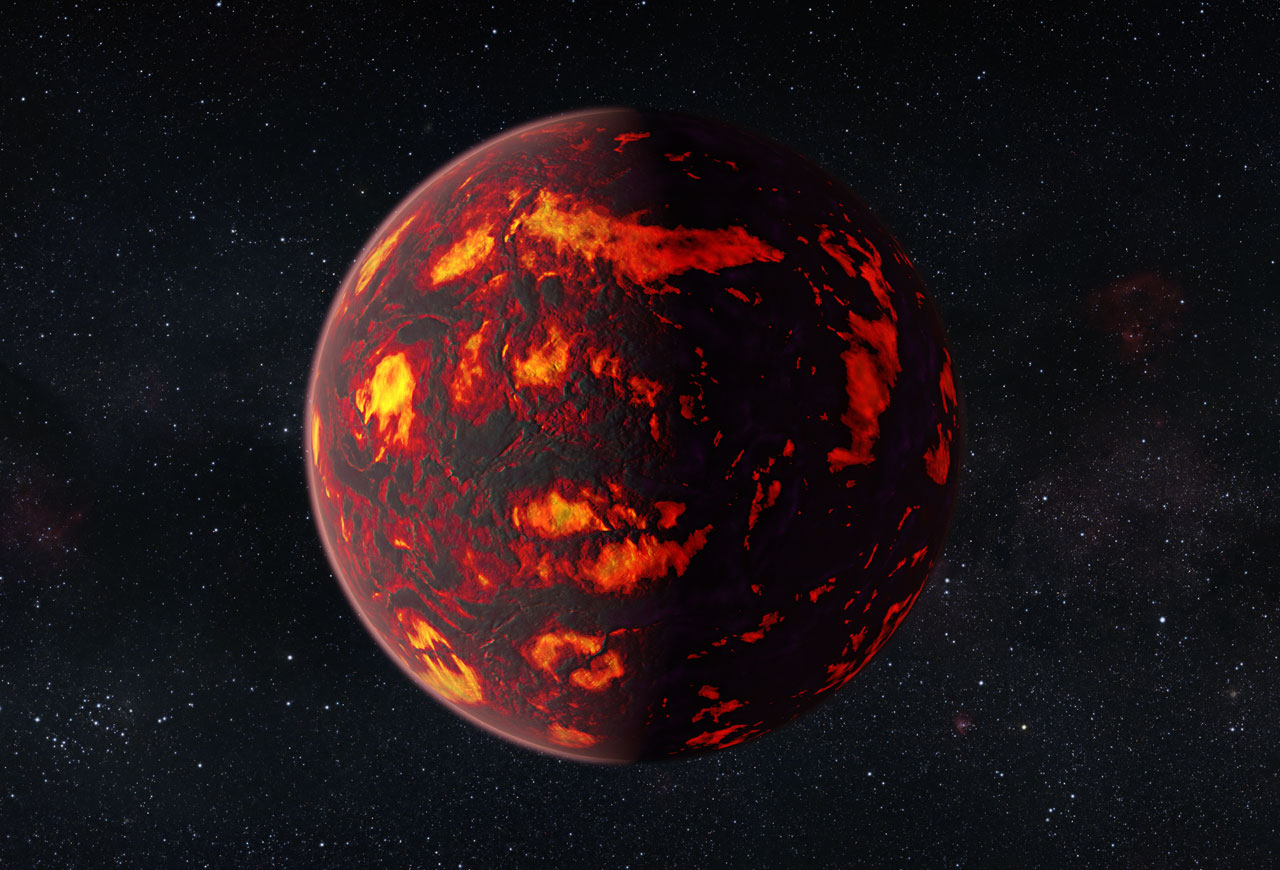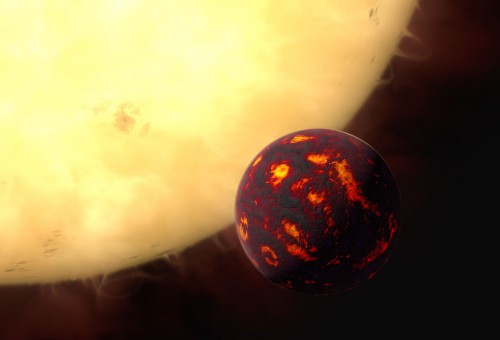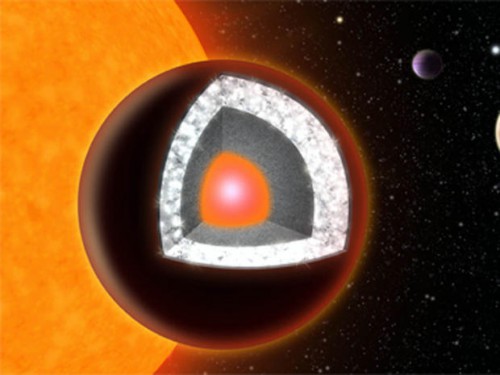
Exoplanets are now being discovered by the thousands, but most are so far away that determining anything specific about their composition or atmosphere is currently very difficult. But technology keeps advancing, and scientists are now starting to be able to learn more about them, at least ones which are a bit closer to our own Solar System. One of the most common types of exoplanets are the “super-Earths,” which are larger and more massive than Earth but smaller than Uranus or Neptune. Now, astronomers have been able to analyze the atmosphere of one of these worlds for the first time.
The scientists were able to analyze the atmosphere of the nearby exoplanet 55 Cancri e using the Hubble Space Telescope as well as new techniques. 55 Cancri e has a mass about eight times that of Earth and orbits the star 55 Cancri which is 40 light-years away, “just next door” in galactic terms. The initial studies reveal an atmosphere with hydrogen and helium but no water vapor.
“This is a very exciting result because it’s the first time that we have been able to find the spectral fingerprints that show the gases present in the atmosphere of a super-Earth,” said Angelos Tsiaras, a PhD student at University College London (UCL). “The observations of 55 Cancri e’s atmosphere suggest that the planet has managed to cling on to a significant amount of hydrogen and helium from the nebula from which it originally formed.”

The lack of water vapor might not be surprising, since the planet orbits very close to its star, in only 18 hours and temperatures are estimated to reach as high as 3,600 degrees Fahrenheit (2,000 degrees Celsius). Not a very habitable-sounding place, but being so close to the star made it easier for astronomers to study its atmosphere. As techniques improve, astronomers will be able to study the atmospheres of planets farther out from their stars, including ones in the “habitable zone” where temperatures could allow liquid water to remain on their surfaces.
The new findings have been accepted for publication in the Astrophysical Journal.
The new observations were made using the Wide Field Camera 3 (WFC3) on the Hubble Space Telescope. Two other super-Earths, GJ1214b and HD97658b, had been looked at before by Hubble in 2014, but no spectral information was able to be obtained, which suggested that their atmospheres were obscured by bright clouds or a gas heavier than hydrogen. In the case of 55 Cancri e, the WFC3 was scanned quickly across the star to create multiple spectra which could then be processed using the new analysis techniques – processing through a computer ‘pipeline’ series of analysis. When the planet transits in front of the star, as seen from Earth, some of the light from the star passes through the planet’s atmosphere; certain wavelengths of light are absorbed by atoms in the atmosphere, leaving a spectral “fingerprint” of its makeup. As noted in Discovery News:
“The WFC3 camera on Hubble is a very sensitive instrument, not initially designed to observe bright stars, and the instrument would overexpose like your cell-phone camera held towards the sun would,” said Ingo Waldmann of UCL. “In 2012, the scanning mode was introduced to address this. Essentially we now quickly move Hubble across the star and ‘smear’ the spectrum across the detector. This helps the overexposure issue, but makes the data analysis very difficult.”
“This result gives a first insight into the atmosphere of a super-Earth. We now have clues as to what the planet is currently like and how it might have formed and evolved, and this has important implications for 55 Cancri e and other super-Earths,” said Giovanna Tinetti, also from UCL.
Along with the high temperatures and lack of water, there is another reason why 55 Cancri is both exotic and inhospitable – a hint of hydrogen cyanide (HCN) in the atmosphere as well. Hydrogen cyanide is very poisonous, but its presence also supports the theory that this world is very rich in carbon. In fact, 55 Cancri e had previously been nicknamed the “diamond planet” since earlier studies indicated that its interior is likely carbon-rich; it may have a surface of graphite surrounding a thick layer of diamond instead of water and granite like Earth.
“Such an amount of hydrogen cyanide would indicate an atmosphere with a very high ratio of carbon to oxygen,” said Olivia Venot, KU Leuven, who developed an atmospheric chemical model of 55 Cancri e that supported the analysis of the observations.
More recent observations have suggested however that there may be less carbon inside the planet than first thought, since there is less carbon than previously thought inside the host star.
As Jonathan Tennyson at UCL noted, “If the presence of hydrogen cyanide and other molecules is confirmed in a few years time by the next generation of infrared telescopes, it would support the theory that this planet is indeed carbon rich and a very exotic place. Although hydrogen cyanide, or prussic acid, is highly poisonous, so it is perhaps not a planet I would like to live on!”
From the new paper:
“We report the analysis of two new spectroscopic observations of the super-Earth 55 Cancri e, in the near infrared, obtained with the WFC3 camera onboard the HST. 55 Cancri e orbits so close to its parent star, that temperatures much higher than 2000 K are expected on its surface. Given the brightness of 55 Cancri, the observations were obtained in scanning mode, adopting a very long scanning length and a very high scanning speed. We use our specialized pipeline to take into account systematics introduced by these observational parameters when coupled with the geometrical distortions of the instrument. We measure the transit depth per wavelength channel with an average relative uncertainty of 22 ppm per visit and find modulations that depart from a straight line model with a 6σ confidence level. These results suggest that 55 Cancri e is surrounded by an atmosphere, which is probably hydrogen-rich. Our fully Bayesian spectral retrieval code, T -REx, has identified HCN to be the most likely molecular candidate able to explain the features at 1.42 and 1.54 μm. While additional spectroscopic observations in a broader wavelength range in the infrared will be needed to confirm the HCN detection, we discuss here the implications of such result. Our chemical model, developed with combustion specialists, indicates that relatively high mixing ratios of HCN may be caused by a high C/O ratio. This result suggests this super-Earth is a carbon-rich environment even more exotic than previously thought.”

The 55 Cancri system has five known planets in all, designated 55 Cancri b, c, d, e and f. 55 Cancri is actually a binary star, with the main star (which the planets orbit) being a yellow dwarf a bit smaller and cooler than our Sun, and the smaller star being a red dwarf.
In 2014, astronomers did find evidence for water vapor in the atmosphere of an “exo-Neptune” planet called HAT-P-11b about 120 light-years away. That analysis also showed the atmosphere to be pretty much cloud-free, making it easier to detect the water vapor. It orbits its star in five days, and is thought to have a rocky core and gaseous atmosphere.
“We think that exo-Neptunes may have diverse compositions, which reflect their formation histories,” said study co-author Heather Knutson of the California Institute of Technology in Pasadena. “Now with data like these, we can begin to piece together a narrative for the origin of these distant worlds.”
Super-Earths seem to be common around other stars, although there aren’t any in our own Solar System, with the exception that there may be a newly-found one orbiting much farther out than Neptune, as reported recently in AmericaSpace. Many of them are thought to be rocky worlds, making them potentially habitable for some form of life. Others are probably more similar to the ice or gas giant planets in our Solar System.
The team of astronomers involved in the new study include A. Tsiaras (University College London, UK), M. Rocchetto (University College London, UK), I. P. Waldmann (University College London, UK), O. Venot (Katholieke Universiteit Leuven, Belgium), R. Varley (University College London, UK), G. Morello (University College London, UK), G. Tinetti (University College London, UK), E. J. Barton (University College London, UK), S. N. Yurchenko (University College London, UK) and J. Tennyson (University College London, UK).
In the coming years, astronomers will be able to analyze the atmospheres of more exoplanets, including super-Earths and even Earth-sized worlds. More smaller rocky planets like Earth are starting to be discovered by the Kepler Space Telescope and other telescopes, and some of them are even in the habitable zones of their stars. Finding evidence of life on any of these worlds will still be a challenge, but with results such as those from 55 Cancri e, we are getting much closer. We will need to keep looking however; 55 Cancri may be exotic and not too far away, but you wouldn’t want to live there.
“If we can do this with Hubble, we are very confident that we can significantly improve with future instruments,” Waldmann said, referencing the future James Webb Space Telescope (JWST), Transiting Exoplanet Survey Satellite (TESS) and PLAnetary Transits and Oscillations of stars (PLATO) telescope. “These next-generation facilities will blow the field of exoplanet spectroscopy wide open and allow insight that, to date, we cannot even imagine. In other words, we really are on the threshold of taking planetary science from our Solar System into the galaxy.”
Be sure to “Like” AmericaSpace on Facebook and follow us on Twitter: @AmericaSpace
.




